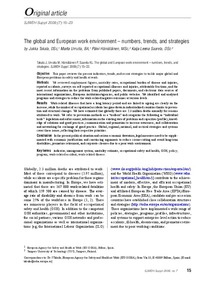The global and European work environment: numbers, trends, and strategies

Takala, Jukka ; Urrutia, M. ; Hämäläinen, Päivi ; Saarela, Kaija Leena
Scandinavian Journal of Work, Environment and Health
2009
Supplement 7
15-23
frequency rates ; mortality ; occupational accidents ; occupational disease ; occupational safety and health ; occupational health survey ; trend
Occupational safety and health
English
"Objective: This paper reviews the present indicators, trends, and recent strategies to tackle major global and European problems in safety and health at work.Methods: We reviewed employment figures, mortality rates, occupational burden of disease and injuries, reported accidents, surveys on self-reported occupational illnesses and injuries, attributable fractions, and the most recent information on the problems from published papers, documents, and electronic data sources of international organizations, European institutions/agencies, and public websites. We identified and analyzed programs and strategies to reduce the work-related negative outcomes at various levels.Results: Work-related illnesses that have a long latency period and are linked to ageing are clearly on the increase, while the number of occupational accidents has gone down in industrialized countries thanks to prevention and structural changes. We have estimated that globally there are 2.3 million deaths annually for reasons attributed to work. We refer to prevention methods as a “toolbox” and categorize the following as “individual tools”: legislation and enforcement, information on the existing state of problems and capacities (profile), knowledge of solutions and good practices, communication and promotion to increase awareness, and collaboration and networking for exchange of good practice. Global, regional, national, and sectoral strategies and systems cover these issues, reflecting their respective priorities.Conclusion: In the present political situation and serious economic downturn, legal measures need to be supplemented with economic justification and convincing arguments to reduce corner-cutting and avoid long-term disabilities, premature retirement, and corporate closures due to a poor work environment."
Digital
The ETUI is co-funded by the European Union. Views and opinions expressed are however those of the author(s) only and do not necessarily reflect those of the European Union or the ETUI.